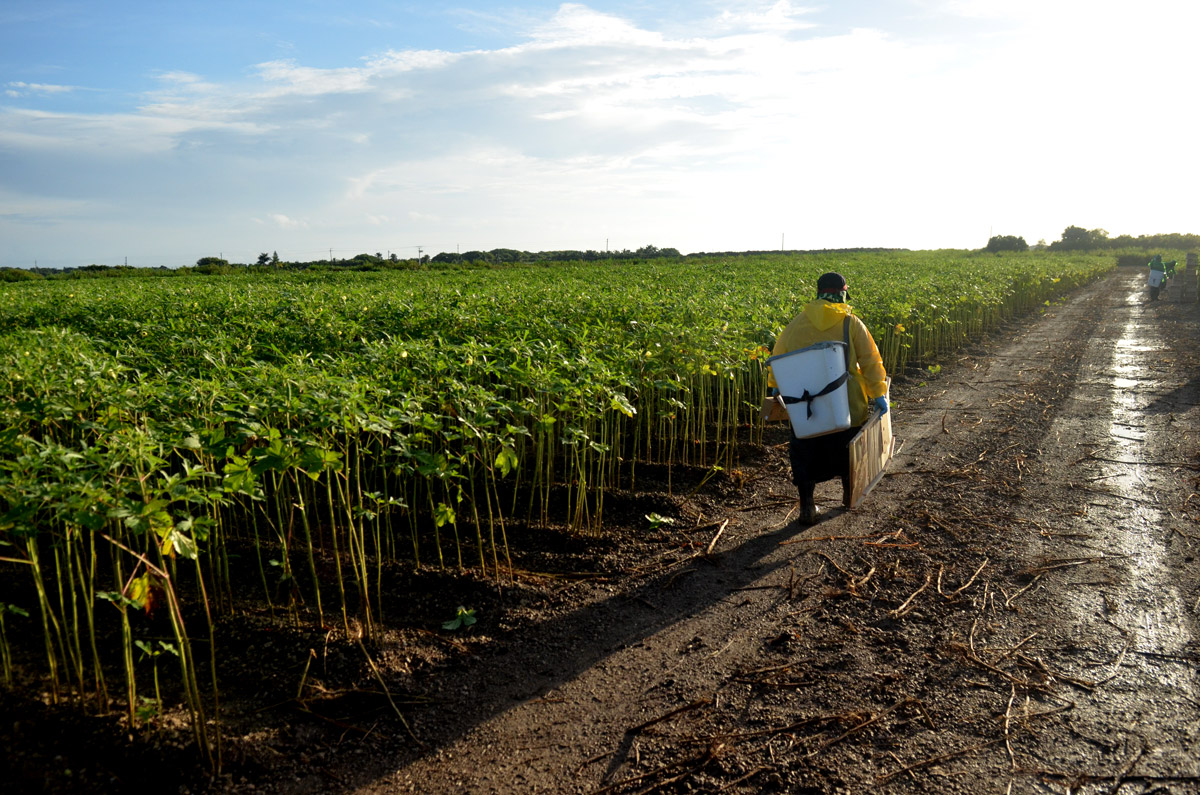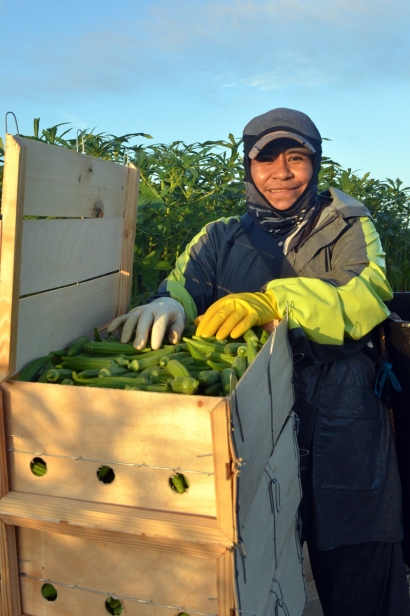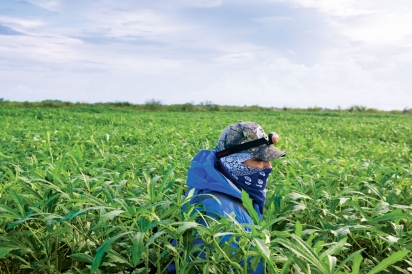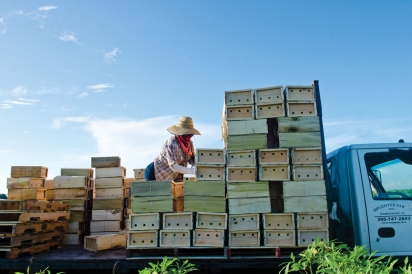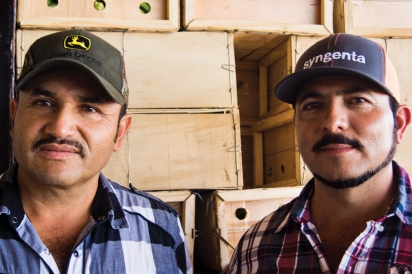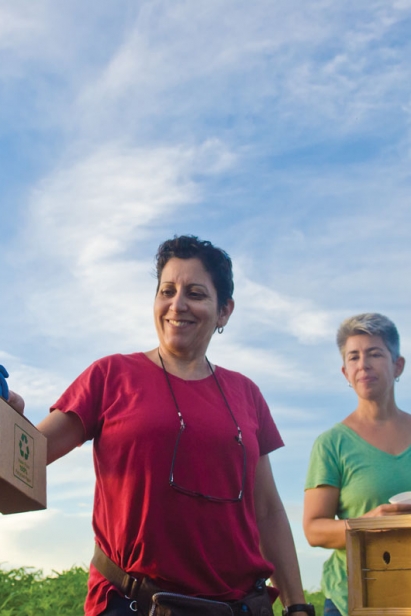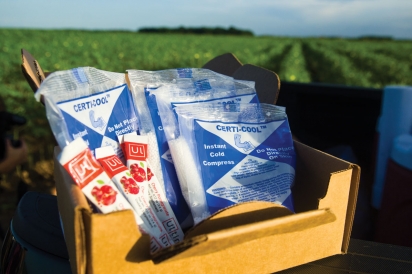Meet Your Farmworker
These farmworkers are the connection between the earth and what diners see on their plates. They harvest the vine-ripe tomatoes, the green beans and the okra that ends up on grocery store shelves, in restaurants and in farmers markets. They are the invisible faces of the food system. These are their stories.
The University of Florida estimates that the United States hires about 1 million farmworkers within the country. Of that 1 million, about 105,700 live and work in Florida, harvesting about 300 different types of produce, from avocados to watermelon. They come from different places. In the last 15 years, Title I Program Director Eduardo Barreiro says he’s seen a more diversified shift in farmworkers who live on federally funded labor camps in Homestead. Of about 800 families living at the three South Dade camps, he says that about 60 percent of them are Mexican, 30 percent are Guatemalan, Honduran or Salvadorean and about 5-10 percent are Cuban.
Most are seasonal workers. They stay in Homestead for about 8 to 10 months before going to other states during the off-season. Farmers living in the South Dade, Redland and Everglades labor camps continue to pay rent for these homes while they work out of state from May through July. “Homestead, Florida is a home state,” Barreiro says. The three local labor camps are considered by many to be a national model of providing adequate housing for farmworkers, who would otherwise be homeless while they worked on the fields. These facilities give farmworkers a place to truly call home.
Some farmworkers are citizens, while some are undocumented – people here without visas, or whose visas have expired. At the Homestead office of the Farmworkers Association of Florida, Elvira Carvajal roughly estimated that half of the people she works with are undocumented.
These workers are a part of the community. “They’re good, hardworking, productive people who just happen to be poor and looking for a better future for themselves and their families,” Barreiro says. “They’re not coming to make trouble. They’re not criminals. They gas up their trucks like everyone else and they want to obey the law.”
Farmworkers are needed here in South Miami-Dade, where the agricultural industry is one of the most diverse in the country, producing more than $2.7 billion in economic impact each year with the “most varied crops in the country,” says Charles LaPradd, the county’s agricultural manager. These include row crops, fruits and landscape plants, he says, ticking off some key crops: “Asian, traditional and tropical row crops like green beans, yellow squash, zucchini, sweet corn and eggplant; myriad potatoes like sweet potatoes; okra, avocados, longans, lychee, bitter melon, bitter gourd, long beans, white guava and dragonfruit. Lots of various herbs, like the many types of basil.”
Here are the stories of some of the people – documented and undocumented – who pick the produce in South Florida fields.
Dorotea
On the field, Dorotea straps a black plastic trashcan around her shoulders. An oversized straw hat protects her from the sun as she sweats through her black hooded sweatshirt, latex gloves and handkerchief-covered face. While it seems like unusual garb in the 93-degree heat, it serves a purpose, protecting from the elements, the mosquitoes and the stiff leaf hairs of the okra that cause itching. Row by row, she fills her container with okra.
Today, there’s a lot to harvest, and she knows it will be a long day. During peak harvesting times, she’s out on the fields for 12 hours, seven days a week. At 2pm, she and her husband head back home for lunch. Dorotea has to clock in for her second job as a mom and wife. She cooks dinner, cleans the house and gets a little rest before picking up her children from their afterschool center. She makes sure they’ve done their homework, plays math or vocabulary games with them and tucks them into bed. By 10, Dorotea is in bed. It starts again as soon as the alarm buzzes at 3am the next day.
Dorotea’s father brought her here from Oaxaca, Mexico, when she was 12. Growing up, she says her parents were never involved with her or her two sisters because they didn’t understand the language. It was hard for her, so now she’s very involved with her children. She’d love it if her three children chose a job that wasn’t farming.
“It’s not because agriculture isn’t an honest living,” she says in Spanish through a translator. “But it’s very hard work. I’d love for my kids to make a better living and do other jobs.” She remembers taking her oldest daughter Lizbeth to a blueberry field one time when she was out of school. Lizbeth noticed how hard her mother worked, and she told her mother that she would study really hard to become a teacher to help Dorotea out. For Dorotea, her family is her community. From open houses to spending quality time with her children, she knows that farming will give them opportunities she didn’t have.
When she does get a day off, Dorotea normally goes out on the weekends with her husband and children to the Redland Market Village flea market on U.S. 1 to buy chilies, fruits and vegetables. If she can spare an hour to herself, Dorotea watches a telenovela or the Spanish-language entertainment news show El Gordo y la Flaca (The Fat Man and the Skinny Woman). Being a female farmer is difficult, she says. She and her husband work really hard, but at the end of the day, he doesn’t have much to do in the sense of obligation. “I have to do homework with two of my kids, and I’m also breastfeeding my third, and it’s harder because there’s so much to do, and we’re already coming home so tired,” Dorotea says.
Though the work is physically strenuous, being here in the U.S. is an opportunity to work – one she wouldn’t get in Mexico. She knows that by living and working hard enough here, she’ll be able to get the shoes, the house, or the car she and her family need. If there’s one thing she wants the community to know, it’s that she wants to be valued for what she does. “Don’t look down on me or humiliate me because I might have dirty hands, or might not have nice clothes, or live in the best area,” she says. “It takes people like us to be able to get the fruits and vegetables into their hands, and somebody has to do it. There will be people with dirty fingernails, but the product that we give is worth it.
Eufemia
If Eufemia didn’t farm, she’d open a bakery named after her daughter. Right now, she’s learning how to make a Mexican pastry called a concha – a sweet bread with a sugary crust that looks like a tortoise shell or seashell. Eventually, she’d love to learn how to make professional cakes.
Eufemia moved to the U.S. with her father when she was 17. Her mother came later, but her siblings stayed in Mexico. In the fields in this country, she met her husband – also Mexican – and now has three children, a boy and two girls. Eufemia, 30, is soft-spoken with a warm smile and long, dark black hair.
In Homestead, she harvests beans, okra and squash. Her day starts at 5am and sometimes finishes at 11pm. She makes lunch for the children and helps them get ready for school before dropping them off at the bus stop. She takes the youngest, who just turned 2, to daycare, and heads to work. After that, she goes home to organize and spend time with the baby before her two oldest children come back from their afterschool program. Then, it’s homework time before dinner. If it’s not too late, Eufemia takes the kids to the park in Homestead. Her oldest son loves to play soccer, and her daughter takes her bicycle for a spin. The toddler will try to kick the soccer ball around too. After the park, it’s bath time before bed.
On the weekends she isn’t working, Eufemia and her husband take the children to a local Mexican ice cream shop. Her favorite flavor is nance, a small yellow fruit that has a vanilla flavor to it. She also goes to the flea market on the weekends.
Eufemia wants people to know that she and her husband came here to make a living. She says she likes farming. “I always imagine the fruit I pick on the tables of people,” she says through a translator. “I like knowing that’s where it’s going to go eventually, and that always makes me feel good.”
Rachel Bueno
Rachel Bueno is the daughter of migrant farmer parents. Growing up, she lived at the South Dade Labor Camp. She would pick tomatoes and okra with her family each summer, and she hated it. They had to make 100 buckets by the end of the day to make $40. If they didn’t wear gloves, the sticky resin would get on their skin, and Buenos would itch all day. “I hated being a migrant student,” says Bueno. “I was an honor student, involved in clubs, but I would go to school with green fingernails (because when you pick tomatoes, you don’t harvest them ripe, so your fingernails would turn green). Any time off, we spent working in the fields or in the packinghouse. I loved school, but I was ashamed to be a migrant. To me it was this big stigma.”
She was recruited as a peer counselor for the Title I Migrant Program, and she eventually moved her way up to her current position as a counselor. Now, she’s proud of where she came from. She’s able to help other families who are in the same situation she was once in. “A lot of these farmers would rather wake up at 5am and work weekends than be beggars,” she says. She hopes that her story makes others realize they can succeed too.
Pedro and Victor Sifuentes
Before he came to the United States, Pedro Sifuentes was studying to be a lawyer in Mexico. He was supposed to come to Homestead for a couple months to make some money before returning to Mexico. But when he got here, he saw there was a lot of agriculture in the area. He had some experience farming with his father, so he decided to stay. The first couple of days were really difficult because he didn’t know anybody. He slept in a park until he met a friend who helped him out and gave him an apartment to stay in.
Sifuentes worked on the Los Campos farm for four years. Usually, Sifuentes would get two months of vacation. But at that time, his wife was pregnant with their first daughter. He told the farmer that he couldn’t take a vacation because he needed money to support his family. The farmer saw his interest in plants, and he decided to let Sifuentes use 12 acres of land, so that he could make money. In those two months, with those 12 acres, Sifuentes cultivated double of what the farmer would usually harvest. Surprised by this, the farmer told Sifuentes, “You don’t need to work for me. You need to work on your own, and I will support you.” He gave Sifuentes 50 acres to work on, but Sifuentes says he couldn’t pay the rent because he didn’t have the money. That farmer took a chance on him, and told him that Sifuentes could pay him after he had cultivated the land. As the season finished, Sifuentes was able to pay the rent for that year and the following year and buy two tractors. And that’s how the Sifuentes Farm started 16 years ago. To this day, that farmer remains a dear friend, and they share the land and work with each other.
Since that day 16 years ago, the Sifuentes Farm has been growing steadily each year. He’s able to employ people within the community and give them steady work and income. He makes sure he’s close with his workers and
their families. If they ever have problems, Sifuentes helps them. In December, he and his brother Victor host a big event giving gifts to the community. It’s something he brought back from Mexico that he wanted to make a tradition in the U.S.
“What I really want is for everybody to get together, not only here in Homestead, but in the whole world, to give more to the farmworkers,” Sifuentes says through a translator. “I believe that the leaders of this country know that there are a certain number of construction workers, farmers, and people in landscaping who are here to work. Why not give them legal status so they could be comfortable doing what they’re doing and do their work better?”
As a local farm owner and worker, he wants the community to know that what’s grown on his farm, and other farms like his, is something that’s healthy and good and trustworthy, unlike produce from other countries, he says.
When he’s not working, Sifuentes loves going horseback riding with his five children. They go to the community club in Homestead or a field by his house. He also likes to take them to Busch Gardens.
Sifuentes hopes that his children can find more stable jobs outside of agriculture, but he’d support them if they wanted to join the family business. He knows a lot of other people want to do what he’s done, but immigration status is the biggest barricade. He advises farmers who want to start their own farms to get legal status first, then look at government programs that will help them initiate farming. “My job is like therapy,” Sifuentes says. “I love to see the plants and how they grow.”
Art for Good: A Heart for Farmworkers
Suzanne Moe and Marcela Noriega moved to Homestead from Washington, D.C. four years ago. As artists, they were offering community art parties in the area when something they noticed every day started weighing on them: dozens of farmers out in the fields, with the sun beating down on them as they harvested produce.
“What unites us is the sun,” says Moe. “That’s when it clicked for both of us. Everyone here is South Dade, and we all need to stay safe from the heat.”
That’s how Cool Ties was formed in 2014. They discovered that farmworkers are 20 times more likely to suffer from heat-related illness than the general workforce. As artists, not doctors, Moe and Noriega developed cotton ties filled with non-toxic polymer crystals that stay cool when soaked in water – ideal for farmworkers to wear around their necks to keep them cool while working.
Moe and Noriega didn’t stop there. In 2015, they started the nonprofit Art for Good, aimed at expanding Cool Ties nationally and increasing awareness of heat-related illnesses. After handing out Cool Ties to countless farmers, Moe and Noriega realized that many farmers didn’t know the symptoms of heat stroke and other heat-related illnesses. “Cool Ties were a refreshing Band-Aid to a much bigger issue,” says Moe. In August, they started educational workshops for farmers and created heat-stress relief kits. Held in Spanish, the two-hour workshops use demonstrations and slides to relay simple ideas, like the importance of drinking enough water. In one class, a woman tries to suck liquids through a straw – one is water and the other ketchup, illustrating how much harder the body has to work to pump blood when it’s dehydrated. They also go through the three phases of heat-related illness through skits and videos.
“It was like an ‘aha’ moment,” says Moe. “A couple people shared personal stories about people who died, and nobody told them this was how the body functioned.”
Right now, Moe and Noriega are doing the workshops themselves, but they hope to eventually train others. They encourage farm owners to invite them over for workshops. With each seminar, every farmer at the workshop gets a Heat Stress Responder Kit, a recycled cardboard box that includes electrolyte sticks, cold packs, a forehead thermometer, one rescue blanket and a Cool Tie.
The idea is that after the workshop, farmworkers will be able to recognize the symptoms and react in time with the kits to save lives. Moe and Noriega want every farmer to have a kit on hand, but the biggest challenge has been the cost. Right now, farmers provide kits to farmworkers at cost for about $10. Moe and Noriega have been assembling and packaging the kits themselves and have been using money from paint parties to fund these projects. They will eventually be on sale to the public for-profit in order to fund their causes.
Moe and Noriega say that the public can support the cause through PayPal donations, contacting them to volunteer, or buying other merchandise on the Art for Good homepage. They hope they can expand all their efforts to the public, nationally and internationally. “Be cool, be kind, have fun, do good,” says Noriega.


